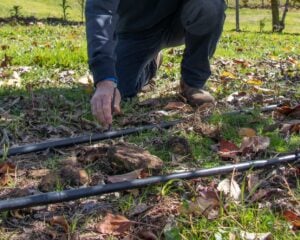Fruit trees are susceptible to damage from hail, frost and storms, drought-induced water stress, heat stress and wind.
Climate models for NSW are predicting rainfall variability to increase, meaning that rainfall will not be as reliable and could fall at different times of the year. Consequently, growers will need to manage their water resources differently and learn to use it more efficiently.
Current predictions indicate that rainfall will increase in autumn and decrease in spring across NSW. This change in rainfall will impact fruit quality and size, which would lower yield and increase reliance on irrigation in temperate fruit orchards.

Irrigation lines in an apple and cherry orchard near Orange, NSW
Using irrigation monitoring and scheduling tools can save water, fertiliser, and labour.
These tools include:
- Soil Moisture sensors,
- Flow Sensors,
- Sap Flow Sensors,
- Bore Sensors, and
- Automatic Irrigation.
Monitoring irrigation and using data to make informed decisions will improve a grower’s ability to be more resilient to climate change by being more efficient with the available water resources. Improving irrigation efficiency will reduce water wastage and help to deliver the required water to the plants, without affecting crop yield or fruit quality. Technology such as soil moisture sensors, flow sensors, sap flow meters, bore sensors and automatic irrigation can assist growers to make informed decisions and help them to respond to increasing climate variability.
More information
For more information read the full article here: Climate-smart irrigation in perennial orchards
Acknowledgements
- This work has been funded by the NSW Primary Industries Climate Change Research Strategy.
- About the Climate Smart Pilots
- This article was reviewed by Tom Flanagan and Darren Price.
- Main image – Irrigation lines in an apple and cherry orchard near Orange, NSW supplied by NSW DPIRD.



